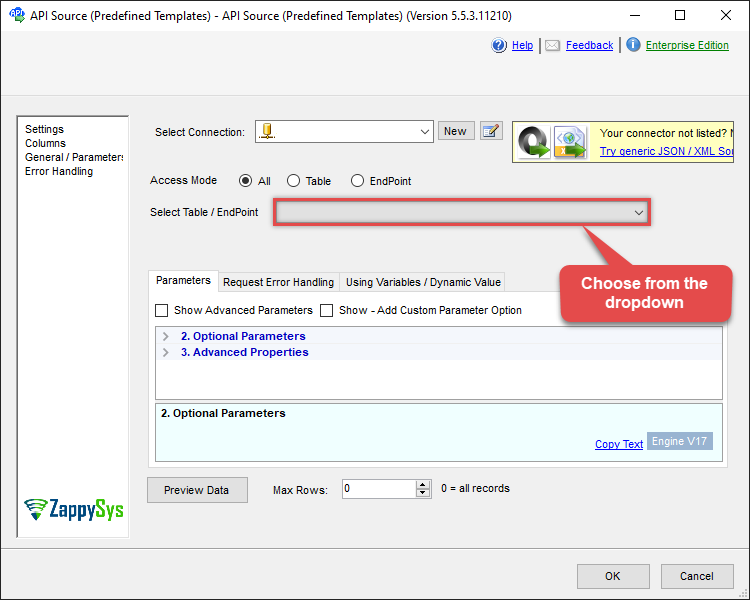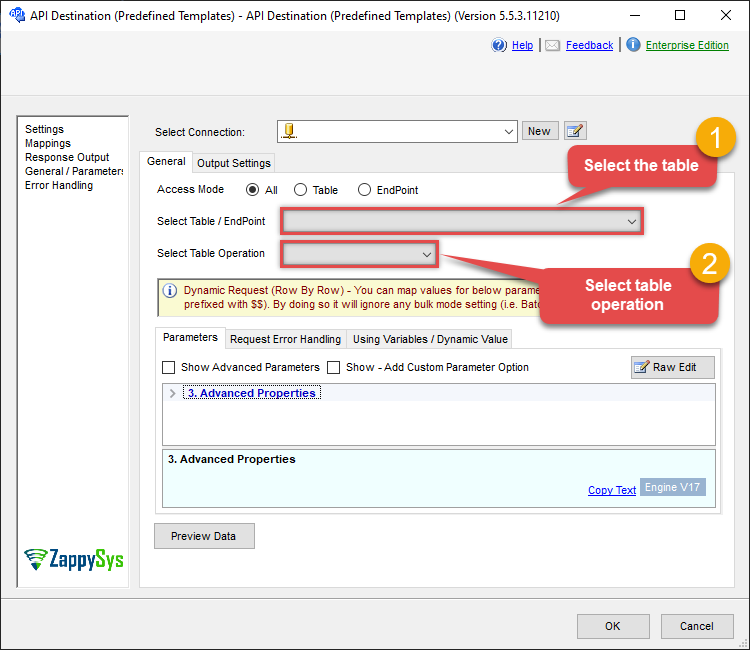Table Tickets_Bulk
Description
No description available
Supported Operations
Below section contains supported CRUD operations. Each operation is executed by some EndPoint behind the scene.| Method | Supported | Reference EndPoint |
|---|---|---|
| SELECT | get_tickets | |
| INSERT | post_tickets | |
| UPDATE | put_tickets | |
| UPSERT | ||
| DELETE | delete_tickets | |
| LOOKUP | get_tickets_by_ids |
Examples
SSIS
Use Zendesk Connector in API Source component to read data or in API Destination component to read/write data:
Read from Tickets (Bulk) table using API Source
API Source - Zendesk
Zendesk Connector can be used to integrate Zendesk REST API in your App / BI Tools. You can read/write data about Tickets, Activity, Users, Organizations and more.
Zendesk
Tickets (Bulk)
| Optional Parameters | |
|---|---|
| Sort By | |
| Sort Order | |
| Extra Columns to Include | |
| External ID for Ticket | |
| NextUrlAttributeOrExpr | $.links.next |
| Records Per Page (Max 100) | 100 |
| NextUrlEndIndicator | false |
| StopIndicatorAttributeOrExpr | $.meta.has_more |

Read/write to Tickets (Bulk) table using API Destination
API Destination - Zendesk
Zendesk Connector can be used to integrate Zendesk REST API in your App / BI Tools. You can read/write data about Tickets, Activity, Users, Organizations and more.
Zendesk
Tickets (Bulk)
Select
| Optional Parameters | |
|---|---|
| Sort By | |
| Sort Order | |
| Extra Columns to Include | |
| External ID for Ticket | |
| NextUrlAttributeOrExpr | $.links.next |
| Records Per Page (Max 100) | 100 |
| NextUrlEndIndicator | false |
| StopIndicatorAttributeOrExpr | $.meta.has_more |

ODBC application
Use these SQL queries in your ODBC application data source:
Delete multiple by tickets by Id list - BULK (comma seperated - max 100 ids)
DELETE FROM Tickets_Bulk WHERE [$$ticket_ids]='111,222,333'Update ticket with Add or remove tags
Update ticket with Add new tags or remove tags. Adding / removing tags available via special field names only in BULK mode so you must use Tickets_BULK table.
Update Tickets_Bulk
SET subject='New subject'
, additional_tags ='["new-tag1","new-tag2"]' --//add some tags
--, remove_tags='["old-tag1","old-tag2"]' --//removes some tags
--, tags='["tag1","tag2"]' --//overwrite all tags
, status='pending' --new, solved, closed
Where Id = 1234Create multiple ticket(s) using a RAW JSON body (single or multiple)
INSERT INTO Tickets_Bulk(_rawdoc_)
VALUES(
'[
{
"subject": "Test ticket #1",
"comment": {
"body": "Test ticket #1"
},
"priority": "urgent"
},
{
"subject": "Test ticket #2",
"comment": {
"body": "This is a comment for #2"
},
"priority": "normal"
}
]'
)SQL Server
Use these SQL queries in SQL Server after you create a data source in Data Gateway:
Delete multiple by tickets by Id list - BULK (comma seperated - max 100 ids)
DECLARE @MyQuery NVARCHAR(MAX) = 'DELETE FROM Tickets_Bulk WHERE [$$ticket_ids]=''111,222,333''';
EXEC (@MyQuery) AT [LS_TO_ZENDESK_IN_GATEWAY];Update ticket with Add or remove tags
Update ticket with Add new tags or remove tags. Adding / removing tags available via special field names only in BULK mode so you must use Tickets_BULK table.
DECLARE @MyQuery NVARCHAR(MAX) = 'Update Tickets_Bulk
SET subject=''New subject''
, additional_tags =''["new-tag1","new-tag2"]'' --//add some tags
--, remove_tags=''["old-tag1","old-tag2"]'' --//removes some tags
--, tags=''["tag1","tag2"]'' --//overwrite all tags
, status=''pending'' --new, solved, closed
Where Id = 1234';
EXEC (@MyQuery) AT [LS_TO_ZENDESK_IN_GATEWAY];Create multiple ticket(s) using a RAW JSON body (single or multiple)
DECLARE @MyQuery NVARCHAR(MAX) = 'INSERT INTO Tickets_Bulk(_rawdoc_)
VALUES(
''[
{
"subject": "Test ticket #1",
"comment": {
"body": "Test ticket #1"
},
"priority": "urgent"
},
{
"subject": "Test ticket #2",
"comment": {
"body": "This is a comment for #2"
},
"priority": "normal"
}
]''
)';
EXEC (@MyQuery) AT [LS_TO_ZENDESK_IN_GATEWAY];